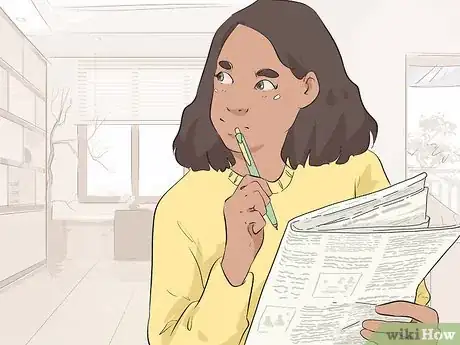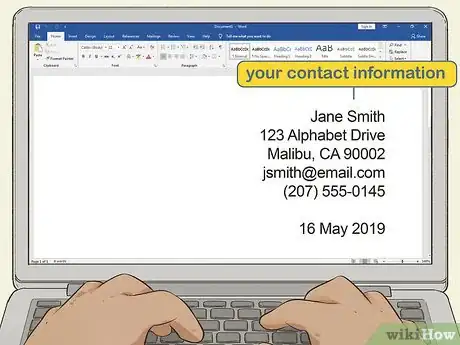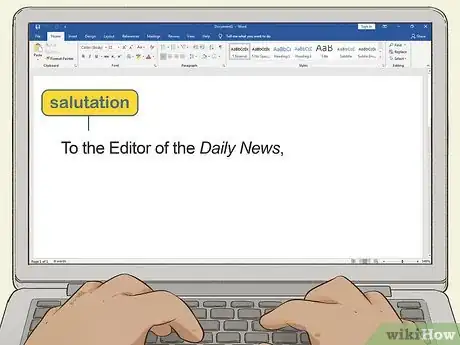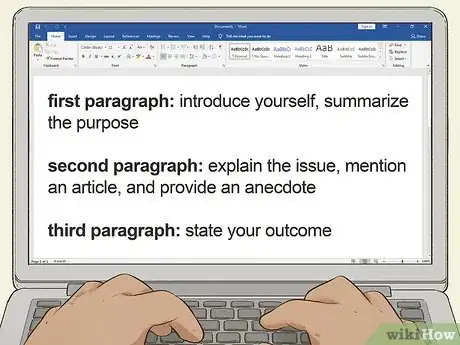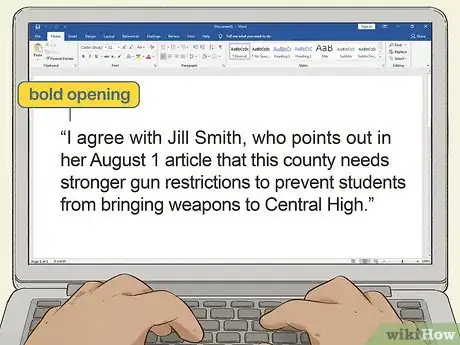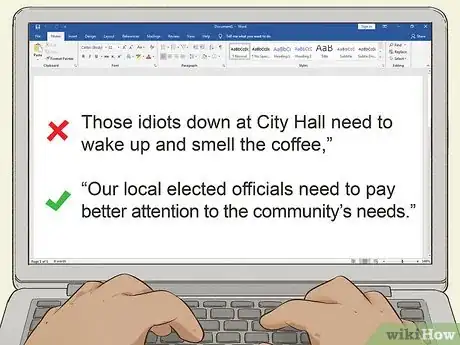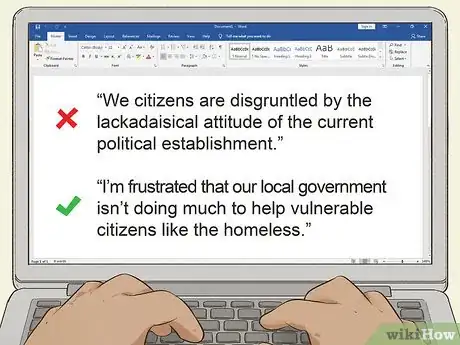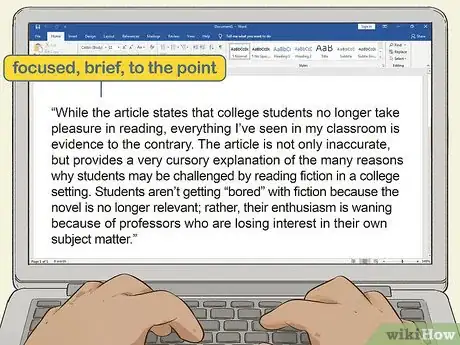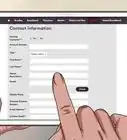This article was co-authored by wikiHow Staff. Our trained team of editors and researchers validate articles for accuracy and comprehensiveness. wikiHow's Content Management Team carefully monitors the work from our editorial staff to ensure that each article is backed by trusted research and meets our high quality standards.
This article has been viewed 12,843 times.
Learn more...
Writing a letter to the editor is a great way to be active in your community and help bring people together to create social change. It’s common to write a letter to the editor of a newspaper if you’d like to respond to an article that you read in the newspaper or other periodical. Writing a letter to the editor gives you a public voice about an issue that you care about, helps keep an issue in public discussion, and can even influence actions taken by elected officials.
Steps
Researching for the Letter
-
1Read a local or national newspaper, whether online or in print. Most newspapers and periodicals are published online, although a few major papers still put out print copies. If you send a letter to the editor of your local newspaper, it’s more likely to be published since fewer people will be sending in letters. However, a letter to the editor of a nationally distributed newspaper will reach a much greater audience.[1] A few major online papers are:
- The Washington Post, at: https://www.washingtonpost.com/.
- The New York Times, at: https://www.nytimes.com/.
- The Wall Street Journal, at: https://www.wsj.com/.
- The Los Angeles Times, at: https://www.latimes.com/.
-
2Identify an issue in the paper that you’re passionate about. Letters to the editor are a place to strongly state your stance on an issue and urge public awareness or action. If you letter comes across as lukewarm, the paper is unlikely to publish it. So, scroll through several issues of the paper until you find an article about an issue that you have strong feelings about.[2] Or, if you already have a topic in mind that you’d like to write about, pursue that idea! Issues that people often write letters to the editor about include:
- State or county taxes
- Subjects taught or not taught at local schools
- Current local or national politics
- Gun control
- Reproductive rights
Advertisement -
3Decide what you think about the issue at stake in the article. Your letter to the editor needs to make a strong claim for or against an issue in order to influence public opinion. So, make up your mind whether you’re in favor of or against an issue that’s been written about in a recent edition of the paper.[3]
- For example, say you’re passionate about funding education and that an article in the local paper states that the town mayor wants to cut school funding in order to improve roads and infrastructure. Arguments could be made both for and against this, so figure out where you stand before putting your thoughts into words.
Formatting the Letter
-
1Include your contact information at the top of the letter. Type this information at the top of the letter, and right-justify it so it stands out from the contents of the letter. Type out your full name, address, and phone number. Include the date. It’s also smart to include your email address in case the newspaper has any follow-up questions regarding your letter.[4]
- Don’t worry about having your personal contact information published. If the newspaper accepts your letter, they’ll only publish your name and the town you live in.
-
2Address the letter to the editors of the newspaper. It’s perfectly acceptable to start a letter to the editor with a generic greeting like, “To the Editor of the Daily News.” You don’t even need to include the name of the paper, since you’re only sending the letter to 1 periodical. However, if you know who edits the newspaper or want to personalize the letter, you can include the editor’s name. You’d write, for example, “To Ms. Smith, Editor.”[5]
- If you’d like to find the editor’s name, look under the “Contact Us” section of the website.
-
3Plan out a 3-paragraph structure for your letter. An effective letter to the editor typically contains 3 paragraphs. Creating an outline of what you want to include in these paragraph can help you focus your thoughts and avoid writing a rambling or confusing letter. In general, a letter to the editor should be structured so that it engages with an issue and takes a clear stance.[6]
- In the first paragraph, introduce yourself as a concerned member of the community and summarize the purpose of the letter.
- In the second paragraph, explain the issue you’re writing about, mention an article from the paper, and provide an anecdote or statistic.
- In the third paragraph, state what you expect the editor (or an elected official) to do about the issue you’ve raised.
Composing the Letter
-
1Write a bold opening sentence that grabs the reader’s attention. Many readers just skim the “Letters to the Editor” section. To hook readers and grab their attention, open your letter to the editor with a strong, decisive sentence that states both the topic of the letter and your stance on the issue. Avoid making sweeping statements that you cannot support with facts. For example, opening your letter by stating, “Gun control has always been a problem in this county,” is too broad.
- Instead, try something like, “I agree with Jill Smith, who points out in her August 1 article that this county needs stronger gun restrictions to prevent students from bringing weapons to Central High.”
-
2Use formal language and avoid slang phrases when writing. A letter to the editor is a formal document and should be written using formal language. This means that you should avoid using slang or colloquial phrases. While it’s fine to write passionately about the subject, you should also avoid making personal attacks in the letter or writing negative things about the paper’s staff or editor.[7]
- For example, instead of writing, “Those idiots down at City Hall need to wake up and smell the coffee,” try something like, “Our local elected officials need to pay better attention to the community’s needs.”
-
3Make an explicit reference to an article in the paper. Papers are unlikely to publish your letter if it reads like a piece of general commentary rather than a specific response to one of the paper’s articles. Referring to a published article also lets you state your stance clearly, as you can open the letter by explaining why you agree or disagree with the article.[8]
- For example, write something like, “I strongly disagree with the article published July 3 which proposes to cut school funding.”
- Or try, “As stated in the article on June 18, I agree that the chief of police needs to resign.”
-
4Write the letter using your own phrasing and style. Rather than trying to sound academic or overly intellectual in your letter to the editor, write it using your own voice. Editors prefer to publish letters from individuals who have strong, informed opinions. If you’re trying to influence public opinion or elected representatives, you’ll have a better chance of doing so if you come across as an authentic, concerned citizen.[9]
- For example, avoid writing something like, “We citizens are disgruntled by the lackadaisical attitude of the current political establishment.” Instead, say, “I’m frustrated that our local government isn’t doing much to help vulnerable citizens like the homeless.”
-
5Keep the letter focused, brief, and to the point. Most letters to the editor are under 250 words long. If your letter gets much longer than that, it may not be published, or the newspaper may edit down the letter. If this happens, you risk losing some of your valuable points.
- Avoid tangents and focus on raising the issue and presenting a call to action.
References
- ↑ https://www.ucsusa.org/action/writing-an-lte.html
- ↑ https://www.aclu.org/other/tips-writing-letter-editor
- ↑ https://ctb.ku.edu/en/table-of-contents/advocacy/direct-action/letters-to-editor/main
- ↑ https://www.aclu.org/other/tips-writing-letter-editor
- ↑ https://ctb.ku.edu/en/table-of-contents/advocacy/direct-action/letters-to-editor/main
- ↑ https://www.successcds.net/learn-english/writing-skills/letter-to-the-editor-format-cbse-class-9-10-12.html
- ↑ https://www.successcds.net/learn-english/writing-skills/letter-to-the-editor-format-cbse-class-9-10-12.html
- ↑ https://www.aclu.org/other/tips-writing-letter-editor
- ↑ https://indivisible.org/resource/write-letters-editor-really-get-attention


